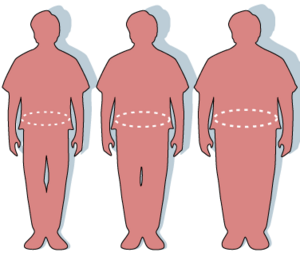Life Style Diseases
Contents
What are Life Style Diseases?
<kaltura-widget kalturaid='292685' size='M' align='R'/>
Life Style Diseases are diseases you get as a result of the way you live. Many of these diseases are related to the social, cultural, religious and ethnic norms of your community and also its economic status. This list includes the deficiency diseases. Others may be described as self inflicted diseases as get them as a result of choices you make. Examples of these are eating disorders such as Anorexia Nervosa , Bulimia, Obesity,sleeplessness. Its mainly caused by life style changes in this precent world.
Vitamin, Mineral, Calorie and Nutrient Deficiency Diseases.
Click Here for Power Point Presentation on the Facts on Deficiency Diseases![]()
- Kwashiorkor and Marasmas are both deficiency diseases. They are differ in that:
- (a) Marasmas results from a deficiency in Vitamin C whild kwashiorkor is protein malnutrition.
- (b) kwashiorkor results from protein malnutrition and marasmas results from a deficeincy in all nutrients.
- (c) Marasmas is a defieciency disease and kwashiorkor is self-inflicted.
- (d) children with Kwashiorkor have distended tummies while those with Marasmas have bent legs.
- A diet rich in Vitamin A is important for healthy
- (a) bones
- (b) nails
- (c) teeth
- (d) vision
- Person living indoors and lack Vitamin D suffer from Rickets as
- (a) Vitamin D and sunlight are essential for the ossification of bones.
- (b) Vitamin D is needed for healthy hair.
- (c) Sunlight is needed for the good vision.
- (d) All of the above.
- The deficiency disease Anaemia may be caused by a lack of
- (a) Iron.
- (b) Vitamin C.
- (c) Vitamin A.
- (d) Vitamin D.
- Anaemia results in a rduction in the number of red blood cells in the blood. People with anaemia tire easily because
- (a) They do not exercise regularly.
- (b) Anaemia affect the lungs.
- (c) Lack of red blood cells impairs the oxygen carrying ability of blood.
- (d) Anaemia affects their sleep patterns.
Feedback:Multiple Choice Questions. If your score is less that three(3), read the content again and redo the questions.
- Question 1
OPTION ANSWER COMMENT A 
Incorrect B 
Incorrect C 
Incorrect D 
Good! 
- Question 2
OPTION ANSWER COMMENT A 
Incorrect B 
Good! 
C 
Incorrect D 
Incorrect - Question 3
OPTION ANSWER COMMENT A 
Good! 
B 
Incorrect C 
Incorrect D 
Incorrect - Question 4
OPTION ANSWER COMMENT A 
Good! 
B 
Incorrect C 
Incorrect D 
Incorrect - Question 5
OPTION ANSWER COMMENT A 
Incorrect B 
Incorrect C 
Good! 
D 
Incorrect Obesity
Obesity is a condition in which the natural energy reserve, stored in the fatty tissue of humans and other mammals, is increased to a point where it is associated with certain health conditions or increased mortality. It is a form of malnuitrition.
Obesity is both an individual clinical condition and is increasingly viewed as a serious public health problem. Excessive body weight has been shown to predispose to various diseases, particularly cardiovascular diseases, diabetes mellitus type 2, sleep apnea, and osteoarthritis.
Causes of Obesity
Overeating
Obesity results when the lifetime energy intake exceeds lifetime energy expenditure by more than it does for individuals of "normal weight".
When food energy intake exceeds energy expenditure, fat cells (and to a lesser extent muscle and liver cells) throughout the body take in the energy and store it as fat.
Other Factors
There are other factors that contribute to obesity. Some of these are beyond your control.
- Your genes and some genetic disorders
- Underlying illness (e.g. hypothyroidism - The Thyroid Glands produces insufficient hormone (thyroxine).
- Eating disorders (e.g., binge eating disorder as in bulimia)
- Certain medications (e.g., some antipsychotics, some fertility medication)
- Sedentary lifestyle - The individual sits or lies down most of the day.
- A high glycemic diet (i.e., a diet that consists of meals that give high blood sugar)
- Weight cycling, caused by repeated attempts to lose weight by dieting
- Stressful mentality
- Insufficient sleep
- Smoking cessation
Poverty
When you look around your country, you would find that there is a relationship between obesity and economic status. For example, in a study conducted in 2004, it was discovered that obese American subjects are approximately half as wealthy as thin ones.
- Yes there is a relationship as fast foods are usually less expensive and therefore more accessable to the poor.
- Through education and the understanding that thry can prepare meals at home from simple unexpensive foods of high nutritional values. They do not have to buy the fast foods which generally have high calorific value and contribute to obesity.
We Will now continue to examine the relationship between obesity an economic status. Consider the following statements.
- Poorer people are often fatter than their richer counterparts. Research has revealed that even when the differences in income were removed from the equation, the inequity persisted — thin subjects were richer than fat ones because of inherited wealth.
- A lower level of education and the tendency to rely on cheaper fast foods might contribute to these results.
- Another study finds women who married into higher status are usually thinner than women who married into lower status.
Measuring Obesity
- The figure at the far right is most obese.
- the measure used here is waist circumference.
Using the Skin Fold Test to determine the Amount of Body Fat.
Another way of measuring obesity is to determine the amount of body fat. Doctors and scientists generally agree that men with more than 25% body fat and women with more than 30% body fat are obese. However, it is difficult to measure body fat precisely. The most accepted method has been to weigh a person underwater, but underwater weighing is a procedure limited to laboratories with special equipment. Two simpler methods for measuring body fat are the skinfold test, in which a pinch of skin is precisely measured to determine the thickness of the subcutaneous fat layer.
The body mass index (BMI) may also be used to measure obesity. body mass index: body mass (in Kg)/height (metres) You are considered obese if your body mass is greater than thirty. the following table shows the body body mass indices standards in relation to obesity.
BMI CATEGORY <20 underweight 20-24 acceptable 25-30 overweight >30 obese
Body mass=Height x BMI - 1.70x35=59.5Kg and 66.5 Kg respectively
Effects on Health
Obesity, especially central obesity (male-type or waist-predominant obesity), is an important risk factor for the "metabolic syndrome" ("syndrome X"), the clustering of a number of diseases and risk factors that heavily predispose for cardiovascular disease. Obesity, especially central obesity (male-type or waist-predominant obesity) is an important risk factor that predisposes the individual for cardiovascular disease, diabetes mellitus type 2, high blood pressure, high blood cholesterol, and triglyceride levels (combined hyperlipidemia).
Apart from the metabolic syndrome, obesity is also correlated (in population studies) with a variety of other complications. For many of these complaints, it has not been clearly established to what extent they are caused directly by obesity itself, or have some other cause (such as limited exercise) that causes obesity as well. Here are some diseases that are related to obesity.
- Cardiovascular: congestive heart failure, enlarged heart and its associated arrhythmias and dizziness, cor pulmonale, varicose veins, and pulmonary embolism
- Endocrine: polycystic ovarian syndrome (PCOS), menstrual disorders, and infertility
- Gastrointestinal: gastroesophageal reflux disease (GERD), fatty liver disease, cholelithiasis (gallstones), hernia, and colorectal cancer
- Renal and genitourinary: erectile dysfunction, urinary incontinence, chronic renal failure, hypogonadism (male), breast cancer (female), uterine cancer (female), stillbirths.
- Integument (skin and appendages): stretch marks, acanthosis nigricans, lymphedema, cellulitis, carbuncles, intertrigo
- Musculoskeletal: hyperuricemia (which predisposes to gout), immobility, osteoarthritis, low back pain
- Neurologic: stroke, meralgia paresthetica, headache, carpal tunnel syndrome, dementia
- Respiratory: dyspnea, obstructive sleep apnea, hypoventilation syndrome, Pickwickian syndrome, asthma
- Psychological: Depression, low self esteem, body dysmorphic disorder, social stigmatization
Diabetes Mellitus
Causes of Diabetes and Glucose Metabolism
- Diabetes is caused by a deficiency of the hormone inulin or the insensitivity of its body cell receptors to the hormone.
- Insulin is produced by Beta cells (β-cells) of the pancreas.
- Insulin is the main hormone that regulates the uptake of glucose, and therefore its removal from the blood.
- After eating a meal rich in carbohydrates, the carbohydrates are converted to glucose.
- The rise in glucose level stimulates the β-cells cells of the pancreas and insulin is released.
- Insulin stimulates the uptake of glucose by cells and its conversion to glycogen which is stored in the Liver and Muscles.
- Some carbohydrates are not converted. Notable examples include fruit sugar (fructose) that is can be broken down by the cell to produce energy. Fructose is not converted to glucose and does not participate in the insulin / glucose metabolic regulatory mechanism; In addition, the carbohydrate cellulose (though it is actually many glucose molecules in long chains) is not converted to glucose, as humans and many animals have no digestive pathway capable of handling cellulose.
The Diagram Glucose Metabolism illustrates glucose metabolism. Click on it and you will be able to see the pathways more clearly.
- If the amount of insulin available is insufficient, or if cells respond poorly to the effects of insulin (insulin insensitivity or resistance), or if the insulin itself is defective, glucose will not be handled properly by body cells, or stored appropriately in the liver and muscles. The net effect is persistent high levels of blood glucose resulting in Diabetes Mellitus.
Anorexia Nervosa
Persons suffering from Anorexia Nervosa have a decreased appetite or aversion to food. Young girls who are very concerned with their appearance are susceptible to this disease. Anorexia is a serious psychological disorder which may lead to emaciation of body tissues and in severe cases death.
Bulimia
Individuals sufferring from Bulimia have insatiable appetites often interrupted by periods of anorexia. Bulimia is characterised by food binging followed by induced vomiting.


